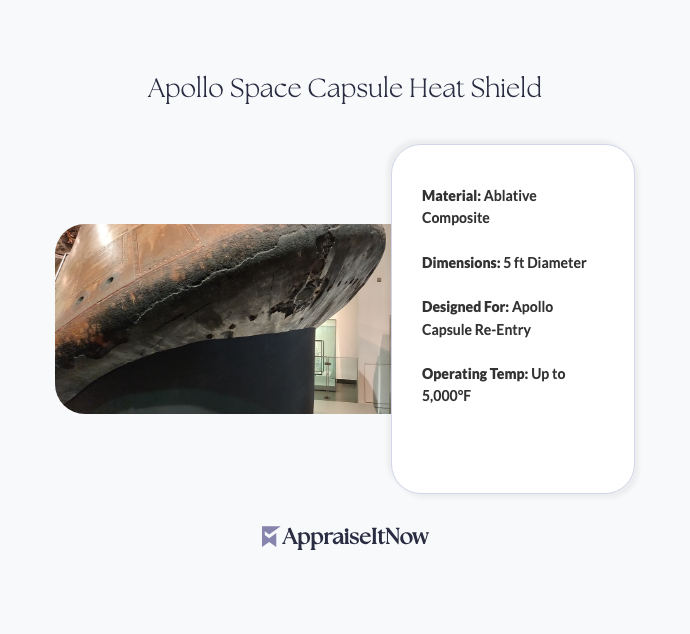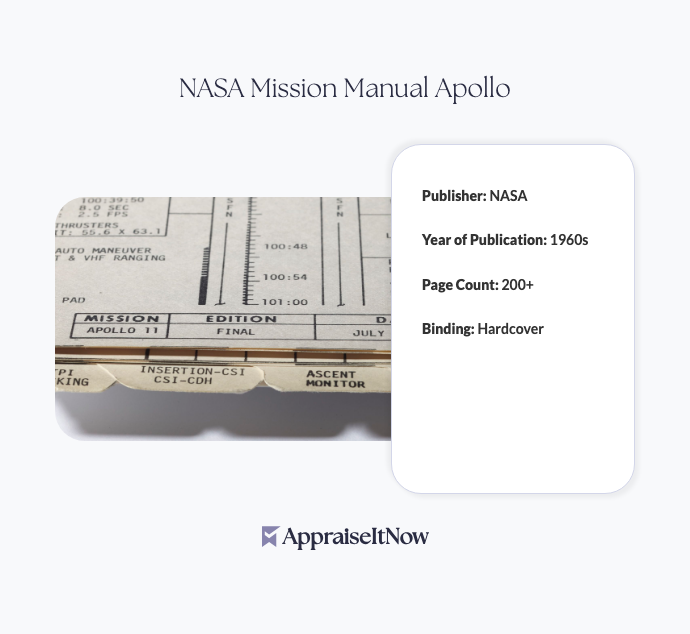<h1>How to Get Your Apollo Space Capsule Heat Shield Appraised</h1>
<p>The Apollo Space Capsule Heat Shield stands as one of the most iconic artifacts from humanity's greatest technological achievement—the journey to the moon. If you own this remarkable piece of space history, understanding its value and securing a proper appraisal is essential whether you're planning to sell, insure, or donate it. Current market estimates place these extraordinary pieces at <strong>$250,000 to $320,000</strong>, though individual examples may vary significantly based on condition, provenance, and historical documentation.</p>
<h2>Why Your Apollo Heat Shield Holds Extraordinary Value</h2>
<p>The Apollo Space Capsule Heat Shield represents far more than scrap metal or engineering debris. This marvel of aerospace engineering played a literal life-or-death role during reentry into Earth's atmosphere, withstanding temperatures exceeding <strong>5,000°F</strong> through its ingenious ablative design. The heat shield's ability to dissipate the immense thermal energy generated by atmospheric friction made it absolutely critical to astronaut safety during every Apollo mission, including the historic Apollo 11 lunar landing.</p>
<div class="callout tip"><p><strong>Historical Context</strong></p>
<p>The heat shield was first used on the Apollo 4 mission, demonstrating its effectiveness before it protected the astronauts who walked on the moon.</p></div>
<p>What makes your heat shield particularly valuable extends beyond its technical specifications. These components were meticulously engineered from specialized ablative materials—compounds specifically formulated to burn away in a controlled manner, sacrificing themselves to protect the crew capsule and its precious human cargo. Only a few dozen surviving specimens exist today, making each one a rare connection to the Space Age. This scarcity, combined with the shield's direct association with humanity's greatest technological triumph, positions it among the most sought-after space exploration artifacts in the world.</p>
<h2>Understanding What Affects Apollo Heat Shield Appraisals</h2>
<p>When evaluating your heat shield's worth, appraisers examine multiple interconnected factors that collectively determine market value. The specific Apollo mission from which your heat shield came carries tremendous significance—hardware from the lunar landings commands substantially higher valuations than components from unmanned test flights, even though all Apollo heat shields possess remarkable technical and historical importance.</p>
<p>The physical condition of your artifact directly impacts its appraisal value. Original heat shields recovered from ocean splashdowns show characteristic ablation patterns and thermal scarring that authenticate their flight history. These visual markers of extreme thermal stress become badges of honor rather than damage, as they prove the shield performed exactly as intended. Collectors and institutions particularly value shields that retain their original thermal blackening and surface characteristics, as restoration attempts can actually diminish authenticity and monetary worth.</p>
<p>Documentation proving your heat shield's flight history represents perhaps the single most important value driver. When you can definitively trace your artifact to a specific Apollo mission, you're not simply appraising metal and materials—you're certifying a direct link to one of humanity's greatest achievements. This is why working with appraisers specializing in <a href="/types/memorabilia-and-collectibles">space exploration memorabilia and collectibles</a> proves invaluable. Professional authentication through detailed provenance research transforms a mysterious artifact into a historically significant treasure.</p>
<div class="callout note"><p><strong>Appraisal Essential</strong></p>
<p>Complete documentation of your Apollo heat shield's mission assignment, recovery location, and previous ownership can add 15-25% to its appraised value.</p></div>
<h2>The Role of Provenance in Your Apollo Heat Shield's Worth</h2>
<p>How much did Apollo 11 cost in today's money? The entire Apollo program consumed approximately <strong>$280 billion</strong> in current dollars, representing humanity's most expensive and ambitious technological undertaking. This staggering investment means every component carries proportional historical weight. Your heat shield's connection to this epic endeavor depends largely on establishing clear provenance—the documented history of your piece's origin and ownership journey.</p>
<p>Provenance documentation might include museum records, NASA acquisition files, auction house catalogs from previous sales, or correspondence from former owners. Sometimes heat shields change hands multiple times, and tracing this complete chain of custody requires detective work that professional appraisers excel at conducting. Consider how <a href="/blog/appraising-artifacts-and-antiquities-evaluating-historical-finds">appraising artifacts and antiquities</a> requires evaluating historical significance beyond monetary value—your heat shield's documented mission assignment transforms it from anonymous hardware into a specific, irreplaceable historical object.</p>
<p>Without clear provenance, even an authentic Apollo-era heat shield faces valuation challenges. Appraisers become understandably cautious when they cannot definitively establish which mission a shield flew on, or whether it actually experienced spaceflight at all. This is precisely why securing professional appraisal from experts specializing in space memorabilia becomes worth far more than the appraisal fee—the resulting documentation protects your investment and validates your ownership.</p>
<h2>Comparing Apollo Heat Shields to Other Space Artifacts</h2>
<p>Understanding your heat shield's market position helps inform realistic valuation expectations. What was Neil Armstrong's net worth when he died? The astronaut, whose signature appears on countless pieces of Apollo memorabilia, had an estate valued at approximately <strong>$5 million</strong>—illustrating how space exploration artifacts achieve remarkable financial significance. Heat shields, however, carry intrinsic historical weight independent of any single individual's signature, making them distinctly valuable in their own right.</p>
<p>Other Apollo-era artifacts command varying prices based on their direct connection to human spaceflight and moon exploration. A heat shield that protected astronauts on a lunar mission occupies a different value tier than flight-qualified components that remained on Earth or flew on unmanned vehicles. Similarly, heat shields bearing recognizable mission insignia or astronaut signatures might command premiums over unmarked examples, though authenticity verification becomes increasingly critical at higher valuations.</p>
<p>The broader collector market for <a href="/blog/how-to-accurately-determine-the-value-of-your-memorabilia-and-collectibles">space exploration memorabilia</a> has shown remarkable growth as Baby Boomer collectors age and generational wealth transfer accelerates. This expanding pool of collectors with both appreciation and resources to acquire significant pieces supports strong market fundamentals for authenticated, documented heat shields. Your timing for appraisal and potential sale may significantly impact realized value—professional appraisers track these market trends and can advise on optimal timing for your transaction.</p>
<h2>Preparing Your Apollo Heat Shield for Professional Appraisal</h2>
<p>Before contacting an appraiser, compile whatever documentation exists for your heat shield. This might include original acquisition paperwork, previous appraisals, photographs of the artifact in your collection, correspondence about its provenance, or any research you've conducted regarding its specific mission assignment. Even incomplete documentation provides valuable context that accelerates the appraisal process and ensures accuracy.</p>
<p>Photograph your heat shield thoroughly from multiple angles, documenting any distinctive markings, serial numbers, mission insignia, astronaut signatures, or thermal scarring patterns. Close-up images of these details help appraisers evaluate authenticity even before conducting in-person inspection. Avoid any cleaning or restoration attempts before professional assessment—original thermal characteristics and surface conditions carry appraisal significance that well-intentioned restoration might compromise.</p>
<p>When selecting an appraiser, seek professionals with specific experience in <a href="/blog/what-do-appraisers-look-for-when-appraising-antique-artwork">space exploration artifacts and memorabilia valuation</a>. <strong>AppraiseItNow</strong> connects you with credentialed appraisers holding certifications from recognized organizations like AAA, ISA, ASA, CAGA, and AMEA. These experts understand the intersection of aerospace engineering, space history, and collectible valuation—three distinct knowledge domains essential to properly evaluate your Apollo heat shield.</p>
<div class="callout tip"><p><strong>Preparation Strategy</strong></p>
<p>Gather any documentation proving your heat shield's mission assignment before appraisal, as this single factor most dramatically influences final valuation.</p></div>
<h2>Insurance and Estate Planning Considerations</h2>
<p>Why should you get your Apollo heat shield professionally appraised? Insurance companies require certified appraisals to establish replacement value for high-worth items. A heat shield valued at $250,000-$320,000 demands appropriate coverage that only comes through documented professional assessment. Standard homeowner's or collectibles policies typically include sublimits far below these valuations, exposing you to catastrophic risk should loss or damage occur.</p>
<p>Estate planning presents another critical appraisal application. If your heat shield constitutes a significant portion of your estate's value, your heirs will face federal and state tax obligations based on fair market value at death. Professional appraisal documentation prevents disputes among beneficiaries and provides tax authorities with credible valuation support. The cost of thorough appraisal documentation represents a small investment compared to potential tax disputes or family conflicts over asset distribution.</p>
<p>How appraisals maximize your tax deductions for donated items becomes relevant if you're considering donating your heat shield to a museum, educational institution, or public trust. The <a href="/blog/how-appraisals-can-maximize-your-tax-deductions-for-donated-items">IRS requires certified appraisals</a> for charitable donations exceeding $5,000, and appraisers must meet specific qualification standards. A professional valuation protects both your tax benefits and the recipient institution's credibility.</p>
<h2>The Authentication Challenge and Why Experts Matter</h2>
<p>Not every object claiming to be an Apollo heat shield actually flew in space. The space memorabilia market, like most collectibles fields, attracts opportunistic sellers offering misidentified or fabricated items. How can you verify authenticity? This is precisely where professional appraisers earn their value through specialized knowledge and authentication protocols.</p>
<p>Expert appraisers examine physical characteristics that reveal mission history. Heat shields that actually experienced reentry display distinctive ablation patterns reflecting thermal stress from extreme temperatures. Serial numbers and mission designations stamped or etched into the shield connect it to specific NASA records that appraisers can verify. Material composition analysis—sometimes necessary for definitive authentication—can establish whether your shield uses period-correct ablative materials consistent with specific Apollo-era specifications.</p>
<p>The authentication process parallels detailed examination methods used in <a href="/blog/exploring-the-role-of-provenance-in-art-appraisals-assessing-historical-significance">exploring the role of provenance in art appraisals</a>, where historical documentation and technical analysis combine to establish legitimacy. Your Apollo heat shield deserves equally rigorous authentication before valuation commences.</p>
<h2>Market Dynamics and Long-Term Value Trends</h2>
<p>The Apollo heat shield market demonstrates steady appreciation reflecting broader trends in space exploration memorabilia collecting. As fewer surviving examples remain in private hands and museum acquisitions increase, scarcity intensifies value appreciation. Additionally, growing interest in space history among younger collectors expands the potential buyer base for significant artifacts.</p>
<p>Future valuations will likely reflect increasing recognition of space exploration's cultural importance alongside technological achievement. The question of why we can't go to the moon anymore—sometimes asked by those unfamiliar with current space programs—underscores how Apollo represents a distinctive historical moment that many nostalgic collectors wish to preserve through artifact ownership. This emotional connection supports long-term demand for authenticated heat shields.</p>
<p>Professional appraisers track market trends through auction results, private sales data, and dealer networks, positioning them to advise on optimal timing for sale and providing realistic valuation benchmarks. The <strong>$250,000-$320,000</strong> range reflects current market conditions, but individual sales regularly exceed these estimates when exceptional provenance or historical significance applies.</p>
<div class="callout note"><p><strong>Key Takeaway</strong></p>
<p>Your Apollo Space Capsule Heat Shield represents an irreplaceable connection to humanity's greatest technological achievement. Professional appraisal from certified experts ensures accurate valuation, comprehensive documentation, and proper positioning in the collectibles market, whether you're buying, selling, insuring, or preserving this extraordinary artifact for future generations.</p></div>







.avif)







